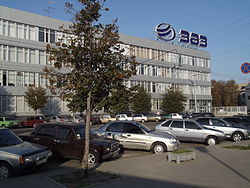ZAZ
 |
|

ZAZ factory in Zaporizhia
|
|
| Subsidiary | |
| Industry | Automotive |
| Founded | 1923 |
| Founder | Soviet Union |
| Headquarters | Zaporizhia, Ukraine |
|
Area served
|
International |
| Products | Cars, vans, buses |
| Revenue |
|
|
|
|
| Parent | UkrAVTO |
| Website | avtozaz.com |
ZAZ or Zaporizhia Automobile Building Plant (Ukrainian: ЗАЗ, Запорізький автомобілебудівельний завод, Zaporiz'kyi avtomobilebudivnyi zavod or Zaporiz'kyi avtozavod) is the main automobile manufacturer of Ukraine, based in the south-eastern city of Zaporizhia. It also produces buses and trucks and is known for its former parent company's name, AvtoZAZ.
The company that became ZAZ developed out of four business founded by German entrepreneur Abraham J. Koop to manufacture agricultural machinery. The factory had been built for local Mennonite industrialist Abraham J. Koop in 1863. It produced iron parts for the windmills, reapers, threshers and plows. They were nationalized and restarted as the state-operated Kommunar factory which continued to produce twenty-four types of machines;. its first combine harvesters appeared in 1929, with 129,724 built by 1952 (not counting the war years). In 1930 Kommunar started to produce the first Soviet harvester Kommunar which was based on the American Holt Caterpillar horse-drawn harvester. The production of the harvester allowed the Soviet Union to cease import of harvesters from abroad.
Design of a car accessible to the public, and one in part taking the place of the soon to be discontinued Moskvitch 401, began in 1956. Following the growing trend of small cars (then accounting for between 25% and 40% of all European car sales), the minister in charge of Minavtroprom (the Soviet automotive ministry) selected the new Fiat 600 as the model to follow. The first prototype, the MZMA 444, appeared in October 1957. It was powered by a flat twin-cylinder MD-65 engine provided by the Irbitskyi Motorcycle Plant, which was "totally unsuited": it produced only 17.5 hp (13.0 kW; 17.7 PS) and lasted only 30,000 km (19,000 mi) between major overhauls. As a result, a search for another engine was begun, and the success of the VW Type 1's boxer led to a preference for an air-cooled engine, which NAMI (the National Automobile Institute) had on the drawing board.Minavtroprom, however, preferred a 23 hp (17 kW; 23 PS) 746 cc (45.5 cu in) V4 engine, the NAMI-G, which had the additional advantage of being developed for the LuAZ-967.
...
Wikipedia
